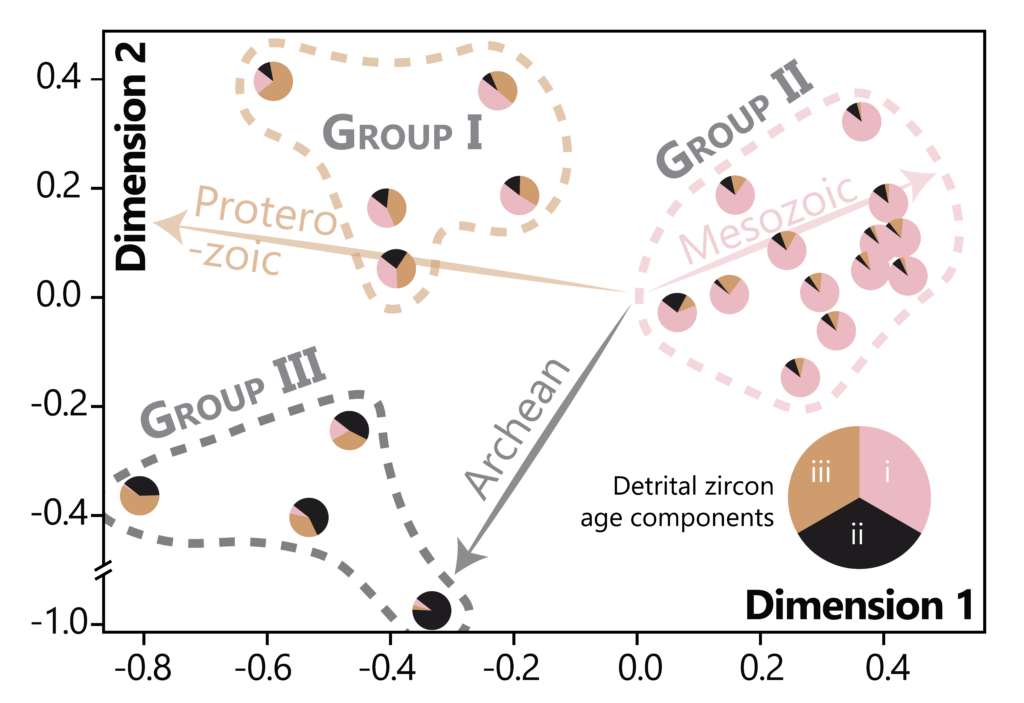Inter-laboratory comparison on detrital zircon age spectra reproducibility
Head in the sand? How reproducible are
detrital zircon
U-Pb age spectra?

Why should we care?
- The relative abundance of age components in detrital zircon age spectra plays a key role in interpreting detrital zircon U-Pb data (e.g., in statistical models)
- Despite the commonality of inter-study detrital zircon comparisons, there is limited understanding of the reproducibility of detrital zircon age spectra produced under different conditions
- Detrital zircon age spectra can be influenced (i.e., biased) by a wide range of geological and methodological factors

Figure 1: Relative abundance of detrital zircon age modes often govern the outcomes of statistical comparisons of detrital zircon age spectra of different samples (e.g., Multidimensional scaling).
Our plan
- We are conducting a community-wide round-robin test to evaluate the reproducibility of detrital zircon data
- We are distributing detrital zircon and heavy mineral concentrates from naturally enriched heavy mineral sand deposits
- We aim to uncover additional biases compared to previous studies by using natural samples with inherent complexities and variability
- One sample (DZ), which is zircon-rich, underwent both heavy liquid and magnetic separation. The other sample (HM), sourced from a different area, was subjected only to heavy liquid separation
- We welcome contributions from researchers with some experience in detrital zircon geochronology
- Since the ‘true’ composition of the samples remains unknown, we will employ various techniques to establish a representative baseline, including high-n approaches and semi-automated selection procedures
- To alleviate concerns regarding potential “outliers”, results will remain anonymous; only one author (Max Dröllner) will know the link between data and contributors

Figure 2: Schematic workflow and timeline for the inter-laboratory comparison of the reproducibility of detrital zircon U-Pb age spectra.
Guidelines for contributors
- Treat the two provided samples DZ (zircon-rich concentrate) and HM (heavy mineral concentrate) as unknown samples for detrital zircon geochronology using LA-ICP-MS (the two samples are independent of each other)
- Conduct quantitative detrital zircon geochronology for both samples to obtain ‘representative’ age distributions
- Contributors have complete freedom in their methodological approach and should follow usual and established workflow for generating ‘publication-worthy’ detrital zircon U-Pb data
- Any sub-sampling, further processing, and mounting of grains is at the discretion of the contributors (Note: Sample DZ underwent heavy liquid separation at 2.9 g/cm3 and conventional magnetic separation, while sample HM underwent only heavy liquid separation)
- There is no proscribed specifics of the methodology (e.g., instrument settings and spot size). Likewise, the number of analyses is at your discretion
- Submit raw isotopic ratios (after data reduction) in a consistent tabular format, preferably using the PlasmAge template (please download the ‘Data reporting template – analytical‘ and fill in your data). Visualizations or further data manipulation, such as applying a discordance filter, are not expected
- Provide metadata, ideally adhering to the PlasmAge guidelines on metadata reporting and data validation (please download the ‘Data reporting template – metadata‘ and provide all details including results of secondary reference material[s])
- Share additional information about grain selection during sample preparation and analytical sessions using a survey form (please download the ‘Sample handling survey form‘ from below)
- Optional: To gain insights into factors causing variability among various methods, contributors are requested to supply high quality mount images or return mounts for imaging (post-analysis), allowing for comparison of grain selection across different contributors
- Please email all analytical results, metadata, and the completed survey form to maximilian.drollner@curtin.edu.au
Outlook
- Comprehensive assessment focusing on understanding the controls of intra-sample variability in the context of various sample handling techniques
- Quantifying the degree of intra-sample variability introduced by different approaches is expected to enhance the robustness of future DZ studies and provide best practice suggestions for handling data generated in different laboratories
- Ultimately, we aim to present our findings at a conference and publish them in a community-driven paper, inviting all contributors to co-author the work
![Fig. 2: (A) Comparison of DZ age spectra of sub-samples prepared using different techniques [3]. (B) Bulk-mounted and handpicked detrital zircon grains show significant different grain colours, aspect ratios, and circularities, suggesting an operator-induced selection bias during handpicking](https://s37430.pcdn.co/scieng/wp-content/uploads/sites/7/2023/05/webpage-03-1024x667.png)
Figure 3: Grain selection can be an important bias in detrital zircon geochronology. (A) Comparison of detrital zircon age spectra of sub-samples prepared using different techniques. (B) Bulk-mounted and handpicked detrital zircon grains show significant different grain colours, aspect ratios, and circularities, suggesting an operator-induced selection bias during handpicking.
Timeline
- Distribution of mineral separates commenced in June 2023
- First samples were shared at the 36th International Meeting of Sedimentology in Dubrovnik, Croatia and further samples were dispatched the week after
- We expect contributors to submit data to us within 10 months after receiving the samples
Relevant publications
- Sláma, J. & Košler, J. Effects of sampling and mineral separation on accuracy of detrital zircon studies. Geochem. Geophys. Geosyst. 13; 10.1029/2012GC004106 (2012).
- Košler, J. et al. U-Pb Detrital Zircon Analysis – Results of an Inter-laboratory Comparison. Geostand Geoanal Res 37, 243–259; 10.1111/j.1751-908X.2013.00245.x (2013).
- Horstwood, M. S. A. et al. Community-Derived Standards for LA-ICP-MS U-(Th-)Pb Geochronology – Uncertainty Propagation, Age Interpretation and Data Reporting. Geostand Geoanal Res 40, 311–332; 10.1111/j.1751-908X.2016.00379.x (2016).
- Chew, D., O’Sullivan, G., Caracciolo, L., Mark, C. & Tyrrell, S. Sourcing the sand: Accessory mineral fertility, analytical and other biases in detrital U-Pb provenance analysis. Earth-Science Reviews 202, 103093; 10.1016/j.earscirev.2020.103093 (2020).
- Dunkl, I. et al. Comparability of heavy mineral data – The first interlaboratory round robin test. Earth-Science Reviews, 103210; 10.1016/j.earscirev.2020.103210 (2020).
- Dröllner, M., Barham, M., Kirkland, C. L. & Ware, B. Every zircon deserves a date: selection bias in detrital geochronology. Geol. Mag. 158, 1135–1142; 10.1017/S0016756821000145 (2021).
We want you!
If you are interested to contribute to this round robin, please fill in the form below to get in contact with us (or send an email to maximilian.drollner@curtin.edu.au). Please provide a brief overview about your expertise in detrital zircon U-Pb geochronology including references to published work.